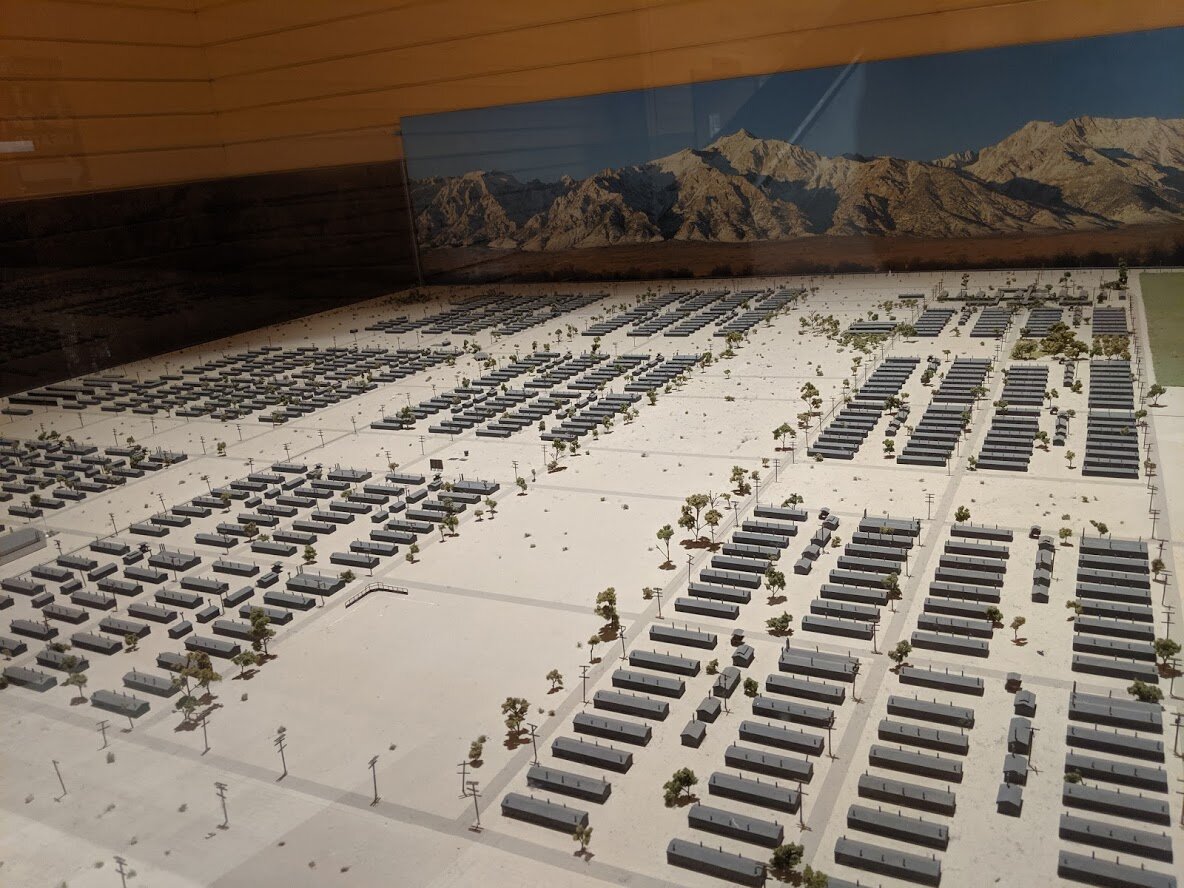I’m ashamed to admit it, but while planning our road trip, I had no idea that we would be passing by the Manzanar National Historic Site. As soon as I realized how close we were to Manzanar, I knew that we had to leave behind the fun part of our day ( Death Valley National Park and Lone Pine Western Film Museum) and confront a dark part of American history.
Shortly after the bombing of Pearl Harbor, President Franklin D. Roosevelt enacted “Executive Order 9066",” which effectively made the west coast of the United States a military zone. As part of this new zone, Americans of Japanese descent were considered a security risk and relocated to interment camps that were located in remote areas of west and mid-west states, ten camps in total. Manzanar, now a historic site of remembrance, was one of the camps.
Here is a model of Manzanar.
For over three and a half years in the 1940’s, over ten thousand Japanese Americans, mostly from the Los Angeles area, where sent here. Over a hundred thousand people were interned in the ten camps. Their experience was abrupt and traumatizing, with many families given only a few days notice to pack up their lives, leaving behind homes, businesses, and pets. This forever altered their lives, as many people emerged from the camps to realize they had completely lost the lives they had built. An apology and a small amount of compensation ( around $20,000 per person still living) did not come until decades later, during Regan’s presidency in 1988.
The visitor’s center has an affecting exhibit that allows you to follow the lives of specific people who were interned at Manzanar.
Visiting Manzanar is an emotional experience. I had a similar gutted feeling when visiting the Anne Frank House in Amsterdam and the Oklahoma City Bombing Memorial. It’s a solemn experience and I certainly cried. I didn’t take very many pictures, as I felt like being present in the moment and truly “listening” with an open heart was most important.
We visited in 2019, while Trump was still president. A presidency marked by inhumanity towards immigrants and separating families. At the time, I could not have imagined how much more rampant hate crimes would become in the US. In particular, the Covid crisis has created a surge in hate directed towards Asians. Visiting Manzanar was a strong reminder of what fear and racism brings if we do not stand against it. It also made me confront my own privileged place in the world.
Despite the sorrow and tragedy, Manzanar is also a place of great hope and humanity. Many of the exhibits emphasized the ways that those interned at Manzanar tried to stay positive and focused on creating a life in the camp. They held dances, arts events, and played sports. The camp had services and businesses, such as hair salons, a library, and a newspaper. Also, the American public was not unanimously in support of the camps, with many people reaching out to those interned, trying to help make their lives better or to be advocates.
After touring the visitors center, we were able to take a self-guided driving tour with stops at several of the cabins. We visited in September and it was scorching hot. The cabins were suffocating from the desert heat, but it also wasn’t hard to imagine how cold they could also be in winter., as they did not have heat or air-conditioning. The cabins were small and sparsely decorated.
This diagram shows the maddening circular form of questioning that Americans of Japanese ancestry had to endure to “prove” their loyalty to the United States. This was at a time with over thirty thousand Japanese American’s fought for their country in World War Two.
After visiting Manzanar, I wish that I had made the effort to visit sooner. The Japanese internment camps, along with many other uncomfortable aspects of American history, should be seen, remembered, and discussed. It is a bit off-the-beaten-path, but I feel that everyone should make the effort to experience Manzanar and the other camps. We need to have these difficult conversations, because truly this is not in our distant past, and based on the climate of our country, it is not hard to imagine something similar happening in our future.







